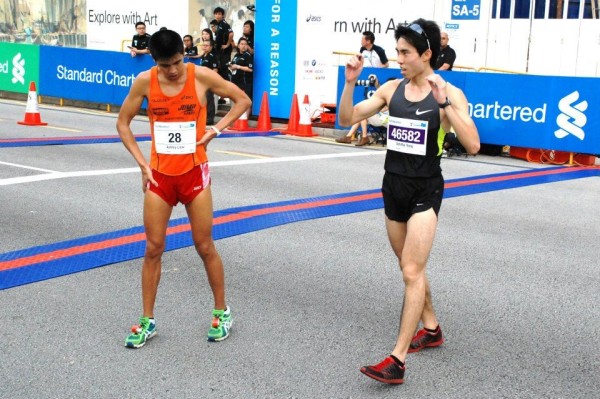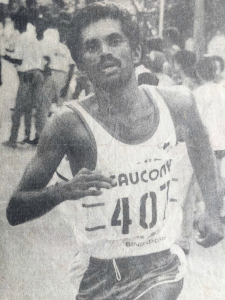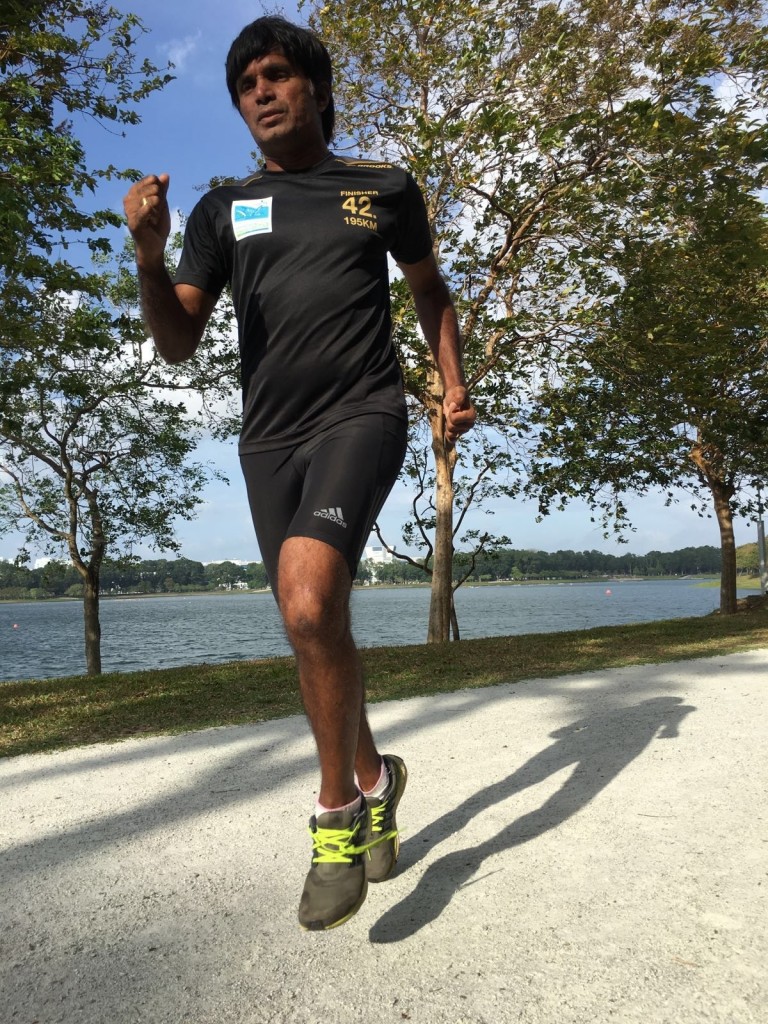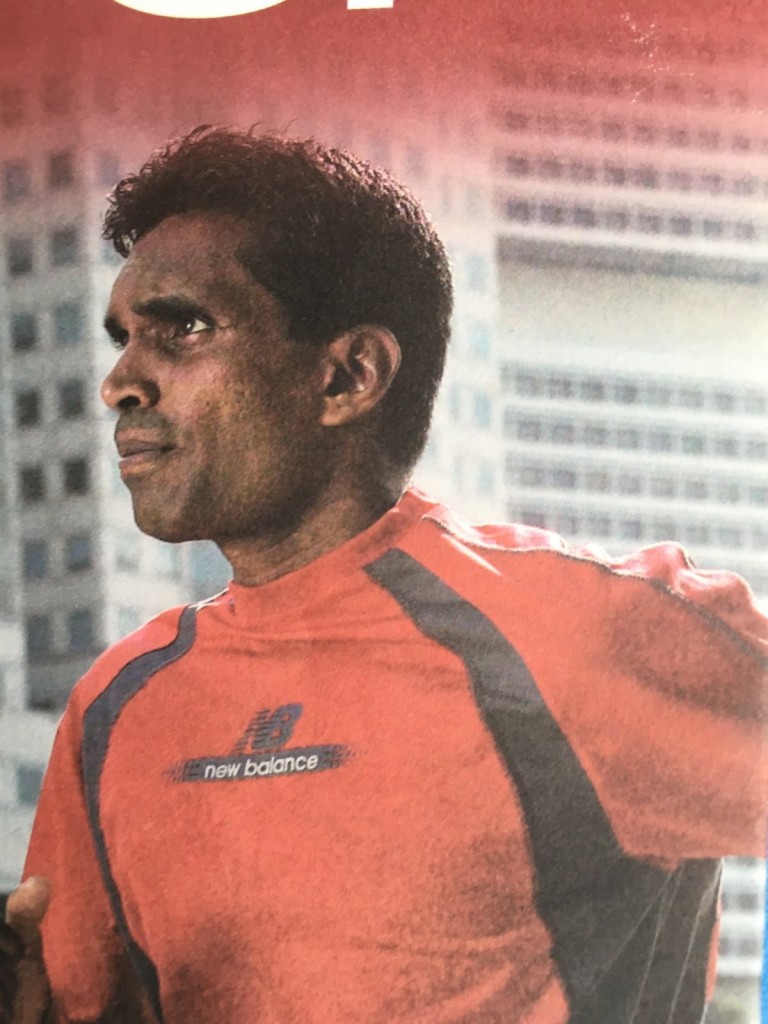Rameshon Murugiah, now aged 50, is well-known amongst the Singapore running community… as the current national record-holder of the marathon.
It is surprising though, that Rameshon started out as having zero interest in running. He said, “Earlier on I was not interested in running. I only started taking it up during my army days in order to get fitter.”
The turning point for Rameshon’s running career had come, when he came first in the 1987 Singapore Marathon, completing the race in 2hours and 40minutes. Since then he realised that he was good in marathon running – and he has never looked back, having gone on to represent Singapore and do the country proud in several overseas marathon events.
Did not expect his record to still be standing
Rameshon’s record marathon timing, 2hours 24minutes and 22seconds, had been set at the 1995 South East Asian Games – and till today it still has not been broken yet.
Said Rameshon, a Director and Coach at FlexiFitness, “I had actually thought my record would have been broken by now. Out of the records set during my era, the 1,500m, 5,000m, 10,000m and half marathon ones have been broken though; I think that it is because I was lucky, that mine is still standing. Last time when I put in all that work into my marathon running, I wondered if it was worth it; but now that my record is still standing, I think I can say that it was.”
The 10,000m record had recently been broken in June 2014, by Soh Rui Yong at the Portland Track Festival in the United States of America. The earlier national record, prior to this, had been set in 1973.
Rameshon added that in the 1995 South East Asia Games where he had set his national marathon record, his main reason for training so hard had been to go for the gold medal. He said, “I was using pure willpower to go for gold but in the last 7km of the marathon, my left leg muscles gave way; I had to choose whether to take a risk or to pull out – I decided to carry on, and nearly got cramp during the last leg of the race. I then decided to forego the gold and push myself to run as fast a timing as possible.”
Rameshon added, “Today, there are three strong runners who are going for my record – Mok Ying Ren, Soh Rui Yong and Ashley Liew. I can’t say who will do it though. As teenagers, they were all much faster than me; only time will tell.”

Ashley Liew (left) and Soh Rui Yong (right) are two of the marathoners who are currently going for Rameshon’s record.
Humility is important for runners
But regardless of who successfully breaks the record, Rameshon feels that what’s more important for runners, is having the trait of humility. He said, “The most important thing is humility. For example, it is of no value if you break the record and start showing off; that defeats the purpose of breaking records. Work hard, put in effort and stay humble.”
But besides having values such as humility, all runners probably still want to do well in their sport. And to that, Rameshon suggests that it is important to keep a logbook to reflect back on their races to see where they had gone wrong.
Runners should keep a logbook and reflect on their races
![Pilots keep a logbook. Why can't runners keep one too, according to Rameshon. [Photo from en.wikipedia.org]](https://www.prischew.com/wp-content/uploads/Pilot_logbook_cover-1024x768.jpg)
Pilots keep a logbook. The runners can keep one too, according to Rameshon.
[Photo from en.wikipedia.org]
Rameshon also cited that there was another time when he took part in a 5,000m race and realised that one of his splits was completed in 1.04 minutes. He said, “I realise that this had been way too fast – I still had another 5.5 rounds of the track to go after that.”
Even if you have run a good race in your opinion though and perhaps clocked a personal best timing, Rameshon stressed that nobody can run a completely perfect race and that there may still be room for improvements.
Prioritise your time well
And for busy runners, Rameshon feels that it is necessary to prioritise their time. He said, “Saying that they like running is one thing, but regarding the top runners, they are able to manage their time very well. If you cannot run for two hours straight then just go out for a 20-minute run; that is better than not running. And if you do not have time for a 10km training run, even a very fast 1km is better than nothing. Or you can do intervals if you are strapped for time – for example run 10 times 100m at maximum pace and rest for 20seconds in between each one.”
He adds that regarding good time management, it is important not to fritter away the little time that you may have, by chatting to friends or surfing Facebook for no apparent reason, and so on, as these are may often be rather unproductive.But at the same time, Rameshon feels that runners should not overdo things and run more often that they should, as having adequate rest is also important.
He says, “For those people with busy jobs, I recommend they take at least 1 day off per week to let their bodies recover. But if you can manage your work well and are getting plenty of rest during the daytime, then you can train everyday. Top athletes such as Haile Gebrselassie train everyday, but they take naps during the daytime to recharge their bodies.”
Adds Rameshon, “But then again it really depends on why you are running. If you just run for fitness then it’s ok to do three to four sessions per week. But if you want to run for performance then I strongly recommend at least five sessions a week, and you may have to train during both mornings and evenings. At one stage I was training three times a day and many people in Kenya do that too.”
But if you really can’t find the time to train and run so frequently, but you still enjoy running, then Rameshon adds that it would be better for you to focus on speed running, for example, taking on 5km and 10km distances, rather than endurance running as your strength may be in there instead. After all, he feels that if you truly lack the time to train for marathons, then do not do them.
Correct posture, technique, and footwear is important
In running, Rameshon also feels that having the correct posture and technique is important – as a running coach to budding athletes from aged six and above, this is what he imparts into his students.
At FlexiFitness, Rameshon’s coaching programmes deal with three different groups of people – budding young champions aged between six and 14 who show talent in the sport, adults aged 15 years and older who want to realise their maximum running potential, and weight loss programmes targeted at all age groups. He coaches all types of distances ranging from sprinters and track athletes, to the 2.4km IPPT as well as 5kms and 10kms, half marathons and marathons.Says Rameshon, “Proper posture and technique is very important in running. For example, many may believe that taking a longer stride when running is good – but that isn’t true. When you take a long stride, the foot strike is in front of the hip so it increases the risk of injuries, either at the knee or the foot.”
Besides good posture, Rameshon also emphases on having the correct footwear. He says, “When you buy shoes, you need to get those that allow the feet to move forward. Most of us may not have injuries but when we choose shoes, the problem comes because the shoes do not fit properly and hinder movement, as a result. This in turn leads to injuries.”
Happy that the Singapore running scene is growing rapidly
And with the Singapore running scene growing rapidly in recent years, Rameshon believes strongly that it is important to educate runners on good running form and running to their own abilities – to ensure them many years of running ahead of them.

When Rameshon had started running, the local running scene had been nowhere as robust as it is today.
Said Rameshon, “When I started running, marathons were not very popular and I never realised that marathon running would become so big till there is now a huge market for them out there. In running I believe that people should learn to take what they are good for – if they are not good at it, then they should dedicate themselves to developing their abilities; I believe that if they don’t want to and don’t have the time to develop themselves and keep on improving, then there’s no point in for example, running marathons.”
He added, “But it is fantastic to see so many people running and getting interested in the sport. Running imparts important values such as discipline, consistency and resilience to bounce back, as well as the tenacity to not give up. These can be applied to life as well as running and can make you into a better person in the long term.”



![Runners should prioritise their time well. [Photo by palmsartgallery.com]](https://www.prischew.com/wp-content/uploads/best_Time_-_good.305184206_std.jpg)
![Posture is also important for runners. [Photo from www.youtube.com]](https://www.prischew.com/wp-content/uploads/maxresdefault-3-1024x576.jpg)
Leave a Comment